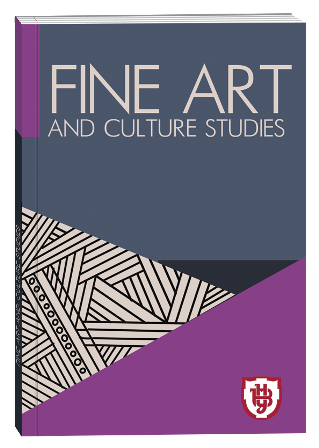IMPROVISATION AND TECHNOLOGIES: INTERACTION BETWEEN ELECTRONICS AND PERCUSSION IN CONTEMPORARY WORKS
DOI:
https://doi.org/10.32782/facs-2025-2-4Keywords:
improvisation, percussion, electronics, live electronics, digital technologies, contemporary music, electroacoustic music, multimedia performance, musician and technology, contemporary musical practicesAbstract
The aim of the study is to analyze the forms and characteristics of interaction between electronics and percussion in contemporary musical works, with a special focus on the role of improvisation as a tool for adaptation and co-creation within technological environments. The research centers on the transformation of the performer's role under digital influence, where improvisation gains not only aesthetic but also communicative significance. The methodology of the study is based on interdisciplinary analysis – combining musicological, performative, and technological approaches. The research includes a historical overview of key stages in the development of electroacoustic music since the 1950s (including the work of studios in Cologne, Paris, and Milan), investigates compositions by such composers as Pierre Schaeffer, Karlheinz Stockhausen, and Luciano Berio, and also analyzes contemporary live electronics practices in the works of Vinko Globokar, Pierre Jodlowski, Anna Korsun, Michael Maierhof, among others. Special attention is given to instrumental setups, types of electronics (analog, digital, interactive), and real-time improvisational methods of interaction.The scientific novelty lies in the conceptualization of improvisation as both a cognitive and artistic strategy that enables flexible interaction between the percussionist and technological environments. Improvisation is considered not only a technique but a form of musical thinking that allows adaptation to changing soundscape parameters and interaction with algorithms, programmed effects, motion sensors, and visual content. The study also highlights the transformation of the performer’s role – from an interpreter to a mediator between the acoustic body and the electronic system, where every gesture, sound, and reaction may have programmed or variable meanings.The main conclusion emphasizes that improvisation at the intersection of acoustic and digital media shapes a new performance paradigm, where the musician acts as an active co-creator of the technological process. This opens up new perspectives for rethinking contemporary musical experience, expands the boundaries of performative freedom, and poses new challenges in terms of corporeality, listening, and interaction within multimedia space.
References
Collins N. Interactive Sound Generation and Improvisation in Live Electronic Music. Leonardo Music Journal. 2006. Vol. 16. P. 45–60.
Emmerson S. Living Electronic Music. Aldershot : Ashgate. 2007. 182 p.
Globokar V. Towards a Theory of Musical Gesture and Improvisation. Contemporary Music Review. 1992. Vol. 7, № 2. P. 112–130.
Jodlowski P. Music and Gesture: Embodied Electronics. Musique en Scène. 2005. № 4. P. 78–85.
Maierhof M. Material, Aktion und Struktur in der aktuellen Musik. MusikTexte. 2004. № 101. P. 43–52.
Schaeffer P. À la recherche d’une musique concrète. Paris : Éditions du Seuil, 1952. 238 p.
Stockhausen K. Mikrophonie I (1964). Texte zur Musik. Köln : DuMont, 1964. Vol. 1. P. 105–110.
Грабовський Л. С. Сучасна українська музика: шляхи розвитку. Музика. 2003. № 4. С. 45–58.
Щетинін О. М. Електроніка в новітній українській музиці: тенденції інтеграції. Питання сучасного музикознавства. 2010. Вип. 9. С. 60–75.
Пілютіков С. В. Імпровізаційні стратегії в музиці ХХ–ХХІ століть. Мистецтвознавчі записки. 2012. Вип. 22. С. 35–47.
Birringer J. Performance, Technology, and Science. PAJ: A Journal of Performance and Art. 2005. Vol. 27. № 2. P. 82–93.
Harley M. A. Xenakis: His Life in Music. New-York : Routledge, 2004. 294 p.
Rebelo P. Embodiment and Music Performance. New Perspectives on Music and Gesture / Gritten A. & King E. New-York : Routledge, 2013. P. 190–207.
Walshe J. M. The New Discipline. MusikTexte. 2012. № 135. P. 1–4.
Winkler T. Composing Interactive Music: Techniques and Ideas Using Max. Cambridge, MA : MIT Press, 1998. 368 p.
Bartleet B. L. Performing the Experimental: Sound Art and Percussion in Practice. New-York : Routledge, 2021. 254 p.
Хміль Г. Тіло як інтерфейс: електроніка і виконавець в новій музиці. Сучасна Музика. 2020. Вип. 3. Ч. 14. С. 32–36.
Toop D. Into the maelstrom: Music, improvisation and the dream of freedom: Before 1970. Bloomsbury : Bloomsbury Academic, 2016. 336 p.
Krause D. Music and Cognitive Science: Challenges of Technology. Oxford : Oxford University Press, 2014.
p.
Stevens T. Percussion and the Mind: Cognitive Processes in Performance. New-York : Routledge, 2017. 224 p.







